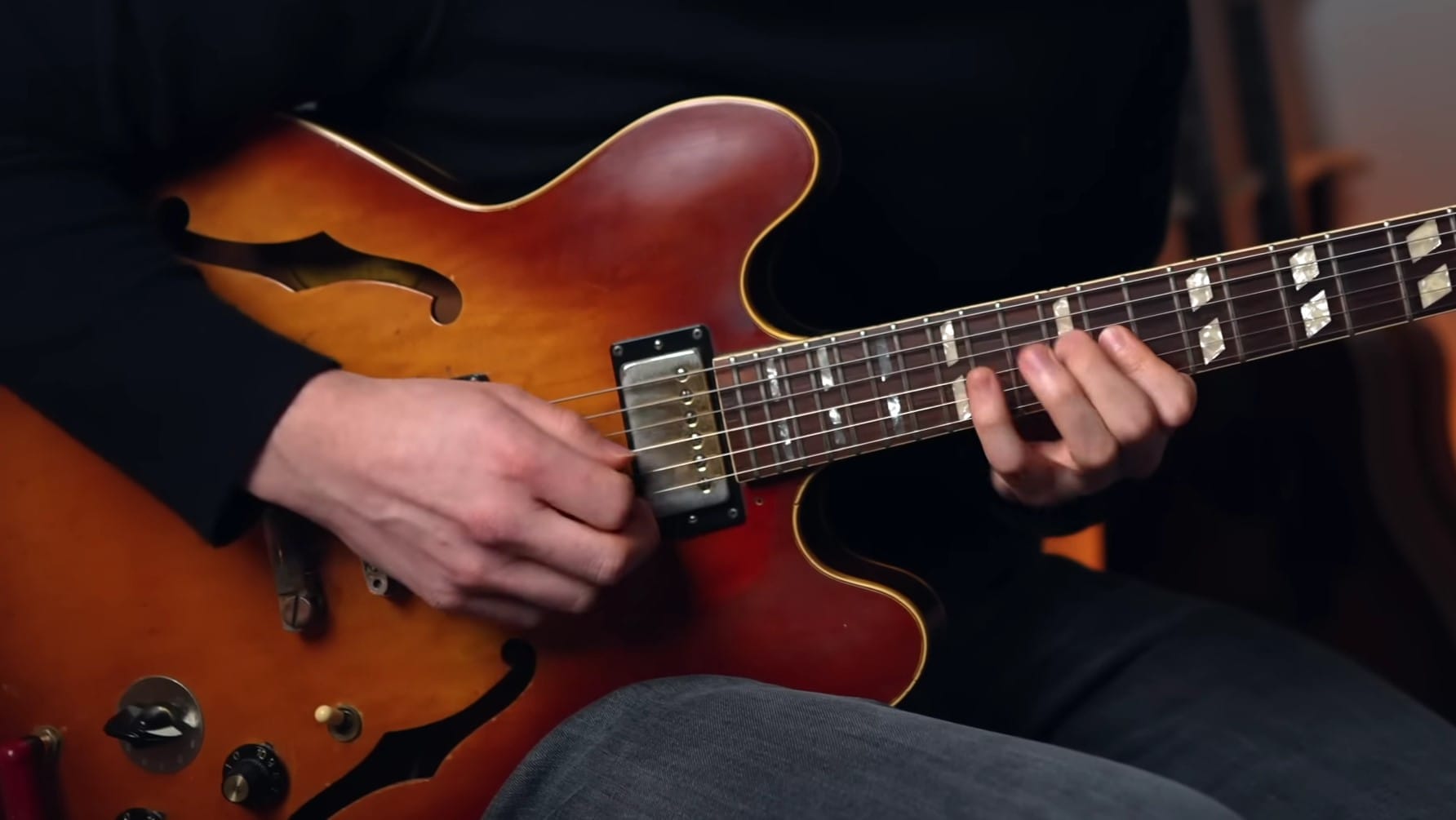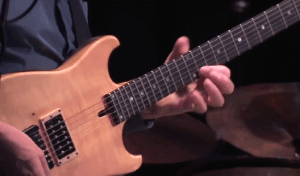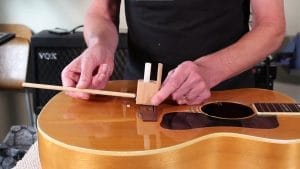Table of Contents
Introduction to Harmonic Minor Scale
The harmonic minor guitar scale is an exotic-sounding musical scale often called the “Arabian Scale.” It differs from the natural minor scale by raising the seventh note in a minor key, creating a slightly different but distinct sound. Which is very popular in Arabic melodies.
The sound of Harmonic Minor Scales is often associated with a Middle Eastern or Spanish musical flavor. The scale is particularly useful for creating tension and dramatic moments in music on both guitar and piano. Let’s know more about it.
Before that, check out some fantastic classical guitars to play these techniques.
Characteristics Of The Harmonic Minor Guitar Scale
Raised Seventh Degree
The only structural difference between the harmonic and natural minor scales is the raised seventh degree.
The seventh degree is a whole step below the tonic in the natural minor scale. A half step in the harmonic minor scale raises the seventh degree. This creates a Major seventh interval.

Tension and Resolution
The raised seventh degree in the harmonic minor scale creates a tritone interval between the seventh and third degrees. This tritone interval contributes to the scale’s distinct sound and creates tension and a desire for resolution.
The resolution often involves moving from the raised 7th degree to the tonic note in the key signature, providing a dramatic and expressive quality to compositions.
Exotic Sound
The harmonic minor scale is often used to evoke exotic or Eastern musical flavors. It is a common choice in genres like flamenco, classical, jazz, and metal, whose unique tonal qualities add tension, drama, and intensity to the music.
Chords
The harmonies derived from the harmonic minor scale differ from those of the natural minor scale.
One of the most notable chords in the harmonic minor scale is the diminished seventh chord, which consists of stacked minor thirds and is commonly used for harmonic tension and resolution.
Learn more about 12-string guitar chords from here!
The dominant fifth chord also captures the flavor of the scale very well and is used frequently in V7 – I resolutions. The Andalusian Cadence is a famous example of how a Major scale is built.
Natural Minor Scale vs. Harmonic Minor Scale
Construction
The formula for the harmonic minor scale is as follows (measured in half-steps or semitones):
- Root (Tonic), the most essential note in the key signature
- The whole step (Major Second) and its note names along the Major scale. Its note names are on a significant scale.
- Half step (Minor Third)
- Whole step (Perfect Fourth), a concept in the lesson, in the Major scale, a concept in the lesson, in the Major scale
- Whole step (Perfect Fifth)
- Half step (Minor Sixth) in the Major scale
- Whole step and a Half step (Raised seventh degree)
- Half step (Octave)
The formula for the minor scale is as follows (measured in half-steps or semitones):
- Root (Tonic)
- Whole step (Major Second)
- Half step (Minor Third)
- Whole step (Perfect Fourth)
- Whole step (Perfect Fifth)
- Half step (Minor Sixth)
- Whole step (Minor Seventh)
- Whole step (Octave)
Sound
The natural minor guitar scale’s sound ranges from soothing and calm to mournful and melancholic. But the harmonic minor guitar scale’s sound ranges from tense and ominous to downright aggressive.
The natural minor scale’s softness comes from the flattened third and sixth intervals. On the other hand, the level of tension in the harmonic minor scale depends on how much the flavor note (the raised seventh) is utilized.
Find Guitars on Amazon.
Chord Progressions
The diatonic chords of The Natural Minor Guitar Scale, a favorite among many, are I, ii, III, iv, v, VI, and VIII. This means the root, fourth, and fifth chords are minor. The third, sixth, and seventh notes’ chords are Major, and the second chord is diminished.
Diatonic chords of The Harmonic Minor Guitar Scale are i, ii, iii aug, iv, V, VI, and video. This implies that the chords of the root and fourth notes are minor in our practice. The chords of the third, fifth, and sixth notes are Major. The third note’s chord is augmented, and the second and seventh notes’ chord is diminished.
The unstable augmented and diminished chords and the dominant fifth chord create the tense and ominous sound of the Harmonic Minor Scale.
Notes and diagrams of all Harmonic Minor Scales
A Harmonic Minor Guitar Scale
The A Harmonic Minor Scale consists of the notes A, B, C, D, E, F, and G#. It has a convenient shape throughout the guitar neck because of the open A string. This scale is frequently used in gypsy jazz, flamenco, etc. style music.
A# Harmonic Minor Guitar Scale
The A# Harmonic Minor Scale consists of notes A sharp, C, C#, D#, F, F#, and A. It has been noted to be used by certain classical composers.
B Harmonic Minor Guitar Scale
The B Harmonic Minor Scale consists of the notes B, C#, D, E, F#, G, and A#. Songs with the Andalusian Cadence have been composed in the B Harmonic Minor scale.
C Harmonic Minor Guitar Scale
The C Harmonic Minor scale consists of the notes C, D, D#, F, G, G#, and A#. DJent artists often use this scale to down-tune to Drop C.
C# Harmonic Minor Guitar Scale
The C# Harmonic Minor Scale consists of the notes C#, D#, E, F#, G#, A and B. This scale is a hit among Nu-metal artists who perform alternating between D# and Drop C# tuning.
D Harmonic Minor Guitar Scale
The D Harmonic Minor Scale consists of the notes D, E, F, G, A, A# and C#. This scale is preferred by death metal artists who tend to tune a whole step down from the standard tuning.
D# Harmonic Minor Guitar Scale
The D# Harmonic Minor Scale consists of the notes D#, F, F#, G#, A#, B, and D. This scale is often used by guitarists who tune in D# standard tuning.
E Harmonic Minor Guitar Scale
The E harmonic Minor scale consists of the notes E, F#, G, A, B, C, and D#. It is the most accessible harmonic minor scale shape throughout the fretboard, as both the first and last guitar strings are open Es.
F Harmonic Minor Guitar Scale
The F Minor scale consists of the notes F, G, G#, A#, C, C#, and E. Flamenco music composers have been noted to use this scale.
F# Harmonic Minor Guitar Scale
The F# Harmonic Minor Scale consists of the notes F#, G#, A, B, C#, D, and F. This is one of the less-used harmonic minor scales.
G Harmonic Minor Guitar Scale
The G Harmonic Minor Scale consists of the notes G, A, A#, C, D, D#, and F#. This is also visited by artists who tune a whole step down from the standard tuning.
G# Harmonic Minor Guitar Scale
The G# Harmonic Minor Scale consists of the notes G#, A#, C, C#, D#, E, and G. Guitarists who use D# standard tuning often use this scale.
Learn Arpeggios after you finish learning the harmonic minor scale here!
Why Guitarists Love The E and A Harmonic Minor Scale Shapes

The guitar is stringed, so the thickest (6th) and thinnest (1st) strings are open E’s. This means that strings played without any frets pressed sound an E note.
As root notes are heavily utilized in musical compositions, having an open note as the tonic is a godsend. Even more so for E since it allows one to start at the bottom of the guitar’s range.
The same reasoning applies to the A (5th) string. E is the root for the dominant chord of A, and the open note of the 6th string is an additional convenience.
Double Harmonic Minor Scales
The double harmonic minor scale, also known as the Byzantine scale or the Arabic scale, is a captivating and exotic musical scale that is less common in Western music but has a unique and alluring sound. It is constructed by flattening the second and raising the sixth degree of the natural minor scale.
Scale Formula
The double harmonic minor scale can be represented with the following formula (measured in half-steps or semitones):
- Root (tonic)
- Half step (Minor second)
- Whole step (Minor third)
- Whole step (Perfect Fourth)
- Whole step (Perfect Fifth)
- Half step (Flattened Sixth)
- Whole and a half step (Major Seventh)
- Half step (Octave)
Find Guitars on Amazon.
Characteristics of the Double Harmonic Minor Scale
Distinctive Sound
The double harmonic minor scale has a unique and exotic sound due to the augmented seconds (three half steps) it contains. This results in intervals not commonly found in Western music, contributing to its exotic and alluring character.
Exotic Flavor
Due to its captivating and foreign tonal qualities, the Minor scale is often associated with Middle Eastern, Eastern European, and Mediterranean music. Using it creates a sense of mystery and allure.
Unconventional Intervals
The augmented second is a less common interval in Western music, and its use in the double harmonic Minor scale adds to its distinctiveness.
Cultural Significance
The scale is a prominent feature of various world music traditions, especially in regions where it is used to evoke a particular cultural or emotional context.
Harmonic Richness
The scale provides a rich harmonic palette, allowing for the creation of complex and colorful chord progressions, which can add depth and complexity to compositions.
You can discover so many unique sounds by playing the scales in experimental tunings! Learn about guitar tunings here.
Famous Songs That Use The Harmonic Minor Guitar Scale
Hotel California by Eagles
Eagles need no introduction; neither does this timeless classic. Hotel California heavily uses the dominant fifth chord and eerie melodies over it. Needless to say, this is all on the harmonic minor scale.
Sultans of Swing by Dire Straits
Sultans of Swing is one of the biggest hits by the British rock legend Dire Straits. The song is mainly on the natural scale, but at the end of every chord progression circle, it shifts to the Harmonic Minor scale.
Paint It, Black by The Rolling Stones
Paint It, Black uses the harmonic minor scale in the key of E, especially in the sitar riff and the guitar solo. The raised seventh-degree contrasts with the natural minor scale used in the verses.
Desert Rose by Sting
Sting is one of the few pop artists who has dared to use the double harmonic minor scale in a mainstream song. A collaboration with Cheb Mami, Desert Rose shines like the desert sun. The instrumental melody generously utilizes the C double harmonic scale’s flavor notes.
From root to the octave
The harmonic minor guitar scale is a valuable tool we’ll explore in this lesson for composers and musicians looking to infuse their music with unique colors and emotions. The harmonic minor guitar scale, a favorite among musicians, its distinctive sound, and the tension created by the raised 7th degree make it an essential scale in various musical contexts.
Harmonic Minor Scale FAQ
Harmonic minor contains seven types of seventh chords: a minor major seventh chord (i), a half-diminished seventh chord (ii), an augmented major seventh chord (III), a minor seventh chord (ivm7), a dominant seventh chord (V7), a major seventh chord (VImaj7), and a diminished seventh chord (viidim7).
The pattern for the harmonic minor scale is: whole step, half step, whole step, whole step, half step, whole step plus a half step, and a half step.
The biggest reason we use the harmonic minor instead of the natural minor is that it allows us to sound like we are in the parallel major, particularly when dealing with cadences or tension resolution. The additional tension resolving to the root sounds better than the natural minor.
The important thing to remember about the harmonic minor scale is that it was developed so that the chords would make a better cadence. In other words, the harmonic minor was invented for making harmonies. That’s where its name comes from.
Interval is the distance between two notes in music.
In any given mode, In any given mode, Scale Degree is the position of a note within a scale, numbered based on its sequence.
- 6 Unique Guitar Picks That Will Blow Your Mind - February 6, 2025
- Master the Harmonic Major Scale And Intervals - February 6, 2025
- 9 Eye Catchy Unique Guitar Straps for Every Musician - February 6, 2025









